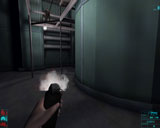 If you haven’t guessed it by now, Die Hard: Nakatomi Plaza is a first
person shooter based on the movie Die Hard. While Die Hard is quite possibly the greatest
action movie ever made, Die Hard: Nakatomi Plaza fails to deliver the same intensity and
adrenaline pumping action of the movie.
If you haven’t guessed it by now, Die Hard: Nakatomi Plaza is a first
person shooter based on the movie Die Hard. While Die Hard is quite possibly the greatest
action movie ever made, Die Hard: Nakatomi Plaza fails to deliver the same intensity and
adrenaline pumping action of the movie. 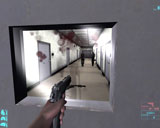 The storyline in DH:NP
is identical to the movie. John McLane goes to Los Angeles to attend his wife’s
Christmas party and try to save their marriage. The party is taking place on the upper
levels of Nakatomi Plaza until terrorists bust in and take everyone hostage. McLane gets
away undetected and sets out on a one-man war to save the hostages. Many of the famous
scenes from the movie are re-created in real time using the game engine and they look kind
of cool. Much of the dialogue from the movie, including ALL of the swearing (can I get
away with a "yippee kai yay motherfucker" in a review Shawn?), is spoken. Sounds
great, but it’s more fun to watch on the big screen than it is to play it all out on
a PC.
The storyline in DH:NP
is identical to the movie. John McLane goes to Los Angeles to attend his wife’s
Christmas party and try to save their marriage. The party is taking place on the upper
levels of Nakatomi Plaza until terrorists bust in and take everyone hostage. McLane gets
away undetected and sets out on a one-man war to save the hostages. Many of the famous
scenes from the movie are re-created in real time using the game engine and they look kind
of cool. Much of the dialogue from the movie, including ALL of the swearing (can I get
away with a "yippee kai yay motherfucker" in a review Shawn?), is spoken. Sounds
great, but it’s more fun to watch on the big screen than it is to play it all out on
a PC.
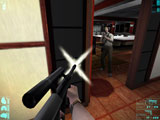 One of the things that make DH:NP different from other first
person shooters is the addition of the morale and stamina meters that appear in the lower
left corner along with your health. The morale meter is affected by how accurate you are,
and how quickly you can get from objective to objective. If you run wildly around the
levels shooting everything in sight, your morale meter will go down. The morale meter, in
theory, will change how the enemies and hostages will react to you. If you morale is high,
the terrorists will be more likely to fall back rather than attacking you. I didn’t
really notice a change in the A.I.’s behavior no matter what my morale meter was
indicating. It is a nice idea, but wasn’t executed very well here. The other meter,
the stamina meter, is a bit more important. In Die Hard: Nakatomi Plaza, running all over
the place drains your stamina so you have to stop and rest every once in a while, or at
the very least walk for a few minutes rather than running. This makes the game play a bit
more realistic, but slows the pace of the game down to a crawl. When I first heard about
the stamina and morale meters I thought they were a great idea, and I still think they
are, but they weren’t used very well in this game.
One of the things that make DH:NP different from other first
person shooters is the addition of the morale and stamina meters that appear in the lower
left corner along with your health. The morale meter is affected by how accurate you are,
and how quickly you can get from objective to objective. If you run wildly around the
levels shooting everything in sight, your morale meter will go down. The morale meter, in
theory, will change how the enemies and hostages will react to you. If you morale is high,
the terrorists will be more likely to fall back rather than attacking you. I didn’t
really notice a change in the A.I.’s behavior no matter what my morale meter was
indicating. It is a nice idea, but wasn’t executed very well here. The other meter,
the stamina meter, is a bit more important. In Die Hard: Nakatomi Plaza, running all over
the place drains your stamina so you have to stop and rest every once in a while, or at
the very least walk for a few minutes rather than running. This makes the game play a bit
more realistic, but slows the pace of the game down to a crawl. When I first heard about
the stamina and morale meters I thought they were a great idea, and I still think they
are, but they weren’t used very well in this game.
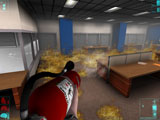 As far as first person shooters go, Die Hard: Nakatomi Plaza is average at
best. While there were only twelve terrorists in the movie, you’ll kill about a
hundred of them by the time the thirty or so levels are said and done. The firefights are
pretty exciting, but they are few and far between. Every time you enter a new area, there
are two or three guys to take care of and then another two or three come along whenever
you complete a puzzle. I would have liked more combat, to be honest. Whenever you do come
across an enemy, it is usually an easy affair as they stand there while you fill their
chest full of lead. It almost always took the A.I. a few seconds to react to me, but by
then they were usually just puddles on the floor. Occasionally they will toss a flash-bang
grenade at you, which will completely blind you for about twenty seconds unless you hear
it hit and turn away, but they rarely take advantage of your temporary blindness.
As far as first person shooters go, Die Hard: Nakatomi Plaza is average at
best. While there were only twelve terrorists in the movie, you’ll kill about a
hundred of them by the time the thirty or so levels are said and done. The firefights are
pretty exciting, but they are few and far between. Every time you enter a new area, there
are two or three guys to take care of and then another two or three come along whenever
you complete a puzzle. I would have liked more combat, to be honest. Whenever you do come
across an enemy, it is usually an easy affair as they stand there while you fill their
chest full of lead. It almost always took the A.I. a few seconds to react to me, but by
then they were usually just puddles on the floor. Occasionally they will toss a flash-bang
grenade at you, which will completely blind you for about twenty seconds unless you hear
it hit and turn away, but they rarely take advantage of your temporary blindness.
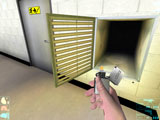 The levels are modeled after their movie counterparts with a few side trips
added on. Since the movie only takes place on a few floors, a lot of the levels
you’ll explore in Nakatomi Plaza are brand spanking new territory. The handful of
levels that were ripped straight from the movie are dead on reconstructions and look
great. Just like in the movie, the levels that feature uncompleted floors have power tools
lying around along with the stacks of drywall that you can turn on in order to create a
diversion while you make a hasty retreat. There are puzzles scattered throughout the
levels, but none of them are too brain taxing. They consist of using an axe to knock down
boards blocking a doorway, using wire cutters to snip wires and open doors, using your
trusty Zippo to light up dark passages, and finding access codes for doors and then
finding the corresponding door. None of them are too hard, but it should be noted that
you’ll be using the wire cutters a lot.
The levels are modeled after their movie counterparts with a few side trips
added on. Since the movie only takes place on a few floors, a lot of the levels
you’ll explore in Nakatomi Plaza are brand spanking new territory. The handful of
levels that were ripped straight from the movie are dead on reconstructions and look
great. Just like in the movie, the levels that feature uncompleted floors have power tools
lying around along with the stacks of drywall that you can turn on in order to create a
diversion while you make a hasty retreat. There are puzzles scattered throughout the
levels, but none of them are too brain taxing. They consist of using an axe to knock down
boards blocking a doorway, using wire cutters to snip wires and open doors, using your
trusty Zippo to light up dark passages, and finding access codes for doors and then
finding the corresponding door. None of them are too hard, but it should be noted that
you’ll be using the wire cutters a lot.
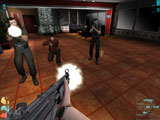 A big part of first person shooters is the guns and other goodies
you can pack around to wreak havoc. In addition to inventory items like the wire cutters,
there are several realistic weapons to use including the HK MP5, the Colt M4A1, the
belt-fed SAW, and the Steyr AUG assault rifle. The MP5 is ripped straight out of the movie
and is what all of the terrorists used. However, since the MP5 is what almost every
character in the game uses, that is all the ammo you’ll find. Ammo for everything
else is pretty much limited to the ammo that was in the gun when you found it. All of the
guns have a realistic spread and recoil, but there is a big problem with the MP5. In the
"real world", the MP5 is widely considered to be the most accurate machine gun
in the world, but in DH:NP, the recoil is so severe that it is actually quite a chore to
keep it on target. In a game striving for realism, omissions like this only serve to spoil
the atmosphere.
A big part of first person shooters is the guns and other goodies
you can pack around to wreak havoc. In addition to inventory items like the wire cutters,
there are several realistic weapons to use including the HK MP5, the Colt M4A1, the
belt-fed SAW, and the Steyr AUG assault rifle. The MP5 is ripped straight out of the movie
and is what all of the terrorists used. However, since the MP5 is what almost every
character in the game uses, that is all the ammo you’ll find. Ammo for everything
else is pretty much limited to the ammo that was in the gun when you found it. All of the
guns have a realistic spread and recoil, but there is a big problem with the MP5. In the
"real world", the MP5 is widely considered to be the most accurate machine gun
in the world, but in DH:NP, the recoil is so severe that it is actually quite a chore to
keep it on target. In a game striving for realism, omissions like this only serve to spoil
the atmosphere.
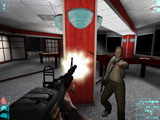 The graphics in Die Hard: Nakatomi Plaza are pretty rough. DH:NP
uses the latest LithTech 3-D engine but not nearly as well as other recent releases No One Lives Forever and Alien vs. Predator 2, both of which also use the
LithTech engine. The environments range from decent looking fully furnished offices to
stark unfinished hallways. Big blocky low resolution textures give everything a blurry
appearance that seriously suffers when compared to first person shooters released within
the last six months or so. Similarly, the character models are simple and look rather
ugly. Their movements are very stiff and seem unnatural, especially their facial
movements. Strangely enough, despite the fact the graphics are rather crude looking, the
frame rate suffers when there is more than one guard on screen. This was a severe problem
as the game would get so choppy it was unplayable. Lowering the resolution helped
somewhat, but the fact that the game ran this poorly on a 1.8GHz Pentium 4 with a GeForce
3 is unacceptable. Bad graphics are one thing, but a bad frame rate to go with them is a
frustrating combination.
The graphics in Die Hard: Nakatomi Plaza are pretty rough. DH:NP
uses the latest LithTech 3-D engine but not nearly as well as other recent releases No One Lives Forever and Alien vs. Predator 2, both of which also use the
LithTech engine. The environments range from decent looking fully furnished offices to
stark unfinished hallways. Big blocky low resolution textures give everything a blurry
appearance that seriously suffers when compared to first person shooters released within
the last six months or so. Similarly, the character models are simple and look rather
ugly. Their movements are very stiff and seem unnatural, especially their facial
movements. Strangely enough, despite the fact the graphics are rather crude looking, the
frame rate suffers when there is more than one guard on screen. This was a severe problem
as the game would get so choppy it was unplayable. Lowering the resolution helped
somewhat, but the fact that the game ran this poorly on a 1.8GHz Pentium 4 with a GeForce
3 is unacceptable. Bad graphics are one thing, but a bad frame rate to go with them is a
frustrating combination.
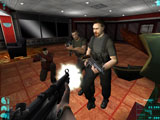 Sound wise, DH:NP is actually pretty good. Rich orchestral scores
perfectly match the action and sound like they are straight out of the movie. Each of the
characters also speaks nearly every line of the movie, and the voice acting is acceptable.
John McLane sounds sort of like Bruce Willis, close enough for me. Hans Gruber has a fake
sounding German accent but, again, it was close enough for me. Most of the main characters
are this way, not perfect, but close enough.
Sound wise, DH:NP is actually pretty good. Rich orchestral scores
perfectly match the action and sound like they are straight out of the movie. Each of the
characters also speaks nearly every line of the movie, and the voice acting is acceptable.
John McLane sounds sort of like Bruce Willis, close enough for me. Hans Gruber has a fake
sounding German accent but, again, it was close enough for me. Most of the main characters
are this way, not perfect, but close enough.
Die Hard: Nakatomi Plaza is a very average game. Imperfections in poorly implemented
features like the morale and stamina meters are magnified by the less than stellar
graphics. I will admit that it is somewhat satisfying to play this game and relive some of
my favorite movie moments. Once you get tired of the cruddy graphics and less than stellar
A.I., which should be rather quickly, there is nothing here to keep you playing. The lack
of a multiplayer option and the poor overall performance keep Die Hard: Nakatomi Plaza
from being recommendable to FPS fans.
